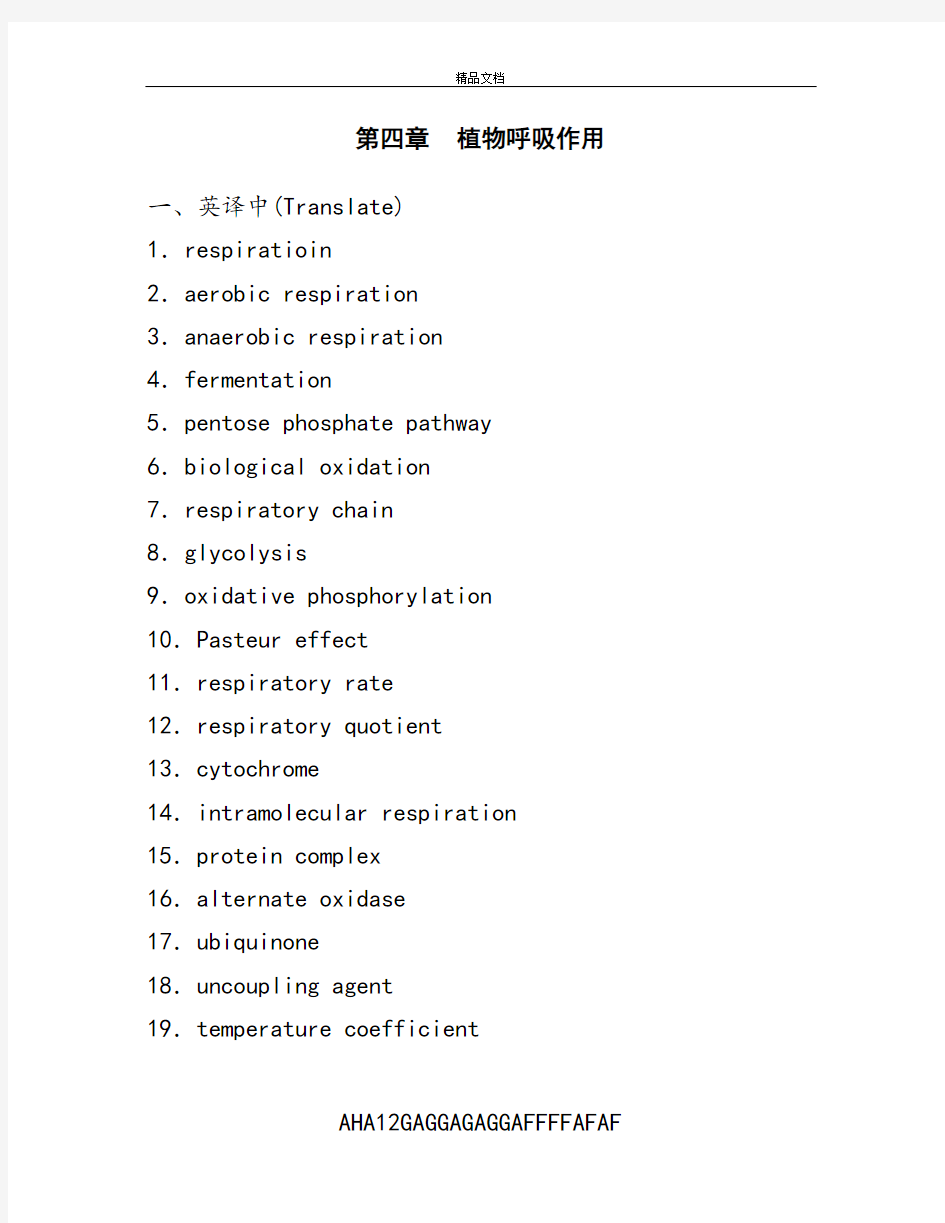第四章 呼吸作用习题及答案


第四章植物呼吸作用
一、英译中(Translate)
1.respiratioin
2.aerobic respiration
3.anaerobic respiration 4.fermentation
5.pentose phosphate pathway 6.biological oxidation
7.respiratory chain
8.glycolysis
9.oxidative phosphorylation 10.Pasteur effect
11.respiratory rate
12.respiratory quotient 13.cytochrome
14.intramolecular respiration 15.protein complex
16.alternate oxidase
17.ubiquinone
18.uncoupling agent
19.temperature coefficient
AHA12GAGGAGAGGAFFFFAFAF
二、中译英(Translate)
1.巴斯德效应
2.有氧呼吸
3.无氧呼吸
4.呼吸速率
5.呼吸商
6.已糖磷酸途径
7.生物氧化
8.电子传递链
9.细胞色素
10.化学渗透假说
11.抗氰呼吸
12.底物水平磷酸化作用
AHA12GAGGAGAGGAFFFFAFAF
13.呼吸链
14.氧化磷酸化
15.发酵
16.分子内呼吸
17.蛋白复合体
18.交替氧化酶
19.温度系数
三、名词解释(Explain the glossary) 1.呼吸作用
2.有氧呼吸
3.糖酵解
4.三羧酸循环
5.生物氧化
6.呼吸链
7.P/O比
8.氧化磷酸化
9.巴斯德效应
10.细胞色素
11.呼吸速率
12.呼吸商
13.抗氰呼吸
AHA12GAGGAGAGGAFFFFAFAF
14.无氧呼吸
15. ADP/O ratio
16.electron transport chain (mitochonrion)
17. oxidative phosphorylation
18. glycolysis
四、是非题(True or false)
( )1.所有生物的生存都需要O2。
( )2.糖酵解途径是在线粒体内发生的。
( )3.在种子吸水后种皮未破裂之前,种子主要进行无氧呼吸。
( )4.戊糖磷酸途径在幼嫩组织中所占比例较大,在老年组织中所占
AHA12GAGGAGAGGAFFFFAFAF
比例较小。
( )5.戊糖磷酸途径是在线粒体膜上进行的。
( )6.高等植物细胞将1mol葡萄糖完全氧化时,净生成38mol。
( )7.细胞色素氧化酶普遍存在于植物组织中。
( )8.线粒体为单层膜的细胞器。
( )9.如果降低环境中的O2的含量,则糖酵解速度会减慢。
( )10.呼吸作用不一定都有氧的消耗和CO2的释放。( )11.糖酵解过程不能直接产生ATP。
( )12.巴斯德效应描述的是三羧酸循环的问题。
( )13.氧化磷酸化是氧化作用和磷酸化作用相偶联进行的过程。
( )14.当植物细胞内的NADPH过多时,不会对戊糖磷酸途径起反馈抑制作用。
( )15.呼吸底物如果是蛋白质,呼吸商则等于1。
( )16.一般来说,随着温度的升高,植物的呼吸作用随之升高。
( )17.呼吸作用的电子传递链位于线粒体的基质中。( )18.由淀粉转变为G—1—P时,需要ATP作用。( )19.对于植物来说,没有呼吸作用,光合作用也就进行不了。
AHA12GAGGAGAGGAFFFFAFAF
( )20.涝害淹死植株是因为无氧呼吸进行过久,累积了酒精,而引
起中毒。
()21.细胞质中1molNADH的电子传给呼吸链中的O2过程中,可产生3mol ATP。
()22. The final electron acceptor in glycolysis is oxygen.
()23. The carrier molecules of electron transport system are located in the cytosol.
()24. Glycolysis is linked to the krebs cycle when oxygen is not available.
()25. Fermentation follows glycolysis in some cells when oxygen is not available.
()26. The highest concentration of hydrogen ions in the mitochondria is in the intermitochondrial space.
AHA12GAGGAGAGGAFFFFAFAF
AHA12GAGGAGAGGAFFFFAFAF ( )27. Each molecule of NADH produced in the
mitochondria provides the enegy for 2.5 ATP molecules.
( )28. The breakdown of glucose in cellular
respiration is not a catabolic reaction
五、选择题(Choose the best answer for each question)
1.水果藏久了,会发生酒味,这很可能是组织发生( )。
2.在呼吸作用中,三羧酸循环的场所是 ( )。
3.种子萌发时,种皮未破裂之前主要进行哪种呼吸( )。
4.三羧酸循环是哪一位科学家首先发现的( )。
5
.三羧酸循环的各个反应的酶存在于( )。
6.三羧酸循环中,
1分子的丙酮酸可以释放几个分子的
CO 2( )
7
.糖酵解中,每摩尔葡萄糖酵解能产生2mol 的丙酮酸以及几
摩尔的ATP( )。
AHA12GAGGAGAGGAFFFFAFAF 8.在呼吸链中的电子传递体是( )。
9.在呼吸链中从NADH 开始,经细胞色素系统至氧,生成H 2O ,
其P/O 比为( )
。
10.EMP 和PPP 的氧化还原辅酶分别为( )。
11.细胞中1mol 丙酮酸完全氧化,能产生多少ATP( )。
12.在下列的植物体氧化酶当中,有哪种是不含金属的
( )。
13.细胞色素氧化酶对氧的亲和能力( )。
AHA12GAGGAGAGGAFFFFAFAF
14.呼吸作用的底物为( )。
15.戊糖磷酸途径主要受什么调节( )。
16
.如果呼吸底物为一些富含氢的物质,如脂肪和蛋白质,则
呼吸商( )。
17.如果把植物从空气中转移到真空装置内,则呼吸速率将
( )。
18.The transition reaction in the cellular respiration
A connects glycolysis to the krebs cycle. B
gives off CO 2
C All of these are correct.
19. Substrate-level phosporylation takes place in
A glycolysis and the krebs cycle
B only
glyolysis
C only the Krebs cycle
D the
respiratory chain
20. How many ATP molecules that are produced during the
complete breadown of glucose
A 30
B 36 C. 38 D 60
21、The greatest contributor of electrons of electrons to the electron transport system is
A oxygen
B glycolysis
C the Krebs cycle
D all of these are correct
22、which of these is not true of fermentation?
A net gain of only two ATP
B occurs in cytosol
C NADH donates electrons to electron transport system
D begins with glucose
23、Carbon dioxide co2given off in respiration procegses.
A glycolysis
B Krebs cycle
C electron transport system
D both A and C are correct.
24、Fatty acids are broken down to
A、pyruvate molecules, which take electrons to the electron transport system
B、acetyl groups, which enter the Krebs cycle
C、amino acids which excrete ammonia
AHA12GAGGAGAGGAFFFFAFAF
D、All of these are correct
25、Oxidative phosphorylation takes place in
A、glycolysis
B、Krebs cycle
C、electron transport system
26、Which process produces both NADH and FADH2 ?
A the Krebs cycle
B glycolysis
C the electron transport system
D fementation
27、Which process reduces molecular oxygen to water?
A、the krebs cycle
B、glycolysis
C、the electron transport system
D、fermentation
28、One turn of the Krebs cycle produces
A、2 NADH, 2FADH2, 2ATP
B、3 NADH, 1FADH2, 1ATP
C、1NADH, 2FADH2, 2ATP
D、3NADH, 3FADH2, 1ATP
29、About of the energy in the sucrose molecule is captured in ATP through the reaction of cellular respiration
A、52%
B、84%
C、36%
D、26%
30、Which of these pairs of processes are anaerobic?
A、fermentation and glycolysis
B、fermentation and the Krebs cycle
C、glycolysis and the krebs cycle
D、glycolysis and the electron transport system.
AHA12GAGGAGAGGAFFFFAFAF
31、The process of splitting larger molecules into smaller ones is an aspect of metabolism called
A、fermentation
B、chemiosmosis
C、anabolism
D、catabolism
32、The pathway through which glucose is degraded to pyruvate is referred to as
A、the citric acid cycle
B、the oxidation of pyruvate
C、glycolysis
D、aerobic respiration
33、The reaction of take place within the cytosol of eukaryotic cells.
A. the electron transport chain
B. chemiosmosis
C. the citric acid cycle
D. glycolysis
AHA12GAGGAGAGGAFFFFAFAF
34、In the first step of the citric acid cycle, acetyl CoA reacts with oxaloacetate to form
A、NADH
B、citrate
C、pyruvate
D、CO2
35、Which of the following is a major source of electrons for the electron transport chain in respiration?
A、ATP
B、NADH
C、H2O
D、coenzyme
36、In the process of electron transport and ATP synthesis are coupled by a proton gradient across the inner mitochondrial membrane.
A、glycolysis
B、anaerobic respiration
C、decarboxylation
D、chemiosmosis
37、Which of the following is a common energy stored in glucose?
A、glucose→oxygen→NADH→water
B、glucose→NADH→ATP→electron transport chain
C、glucose→NADH→electron transport chain→ATP
D、glucose→electron transport chain→ATP→NADH
38、Which multiprotein complex in the respiratory electron transport chain is responsible for reducing molecular oxygen?
https://www.360docs.net/doc/9f13048782.html,plexⅠ(NADH dehydrogenase)
https://www.360docs.net/doc/9f13048782.html,plex Ⅱ(succinate dehydrogenase)
https://www.360docs.net/doc/9f13048782.html,plex Ⅲ(cytochrome bc1 complex)
AHA12GAGGAGAGGAFFFFAFAF
https://www.360docs.net/doc/9f13048782.html,plex Ⅳ(cytochrome oxidase)
https://www.360docs.net/doc/9f13048782.html,plex Ⅴ(ATP
synthase)
六、填空题(put the best word in the blanks)
1.呼吸作用可分和两大类,有氧呼吸的反应式是。
2.三羧酸循环和生物氧化是在进行的。
3.呼吸作用的糖的分解途径有3种,分别是、
和。
4.高等植物从呼吸为主,在特定条件下也可进行
和。
5.三羧酸循环是英国生物化学家首先发现的。6.EMP途径发生于,PPP途径发生于,酒精发酵发生于,TCA循环发生于中。
7.三羧酸循环中的各种酶是存在于线粒体的中。8.EMP和PPP的氧化还原辅酶分别为和。9.生成H2O时,会产生个ATP。
10.戊糖磷酸途径主要受调节。
AHA12GAGGAGAGGAFFFFAFAF
11.线粒体电子传递链中电势跨度最大的一步是在之间。
12.在一定时间内,植物在呼吸作用中释放的CO2和吸收的O2的物质的量的比称为。
13.真核细胞中,1mol葡萄糖完全氧可产生 mol ATP。14.组成呼吸链的传递体可分为和。
15.呼吸抑制剂主要有。
16.如果呼吸底物为糖类,同时又完全氧化,呼吸商为。17.影响呼吸作用的外界因素有、、和等。
18.植物呼吸作用的最适温度一般在之间。
19.早稻浸种催芽时,用温水淋种和时常翻种,其目的就是使。
20.当植物组织受伤时,其呼吸速率。
21.呼吸作用生成ATP的方式有和。
七、问答题(Answer the following question)
1.试述呼吸作用的生理意义。
2.在呼吸作用中,糖的分解代谢有几条途径?分别发生于哪个部位?
3.呼吸作用与光合作用有何联系?
4.试述线粒体内膜上电子传递链的组成。
5.陆生高等植物无氧呼吸过久就会死亡,为什么?
AHA12GAGGAGAGGAFFFFAFAF
6.粮食贮藏时要降低呼吸速率还是要提高呼吸速率?为什么?7.果实成熟时产生呼吸骤变的原因是什么?
8.春天如果温度过低,就会导致秧苗发烂,这是什么原因?9.三羧酸循环的要点和生理意义是什么?
10.试述氧化磷酸化作用的机理。
11.植物细胞内1mol蔗糖彻底氧化成CO2和H2O时,净得多少mol的ATP?
12.Describe how the processes of photosynthesis and cellular respiration are linked, and what aspects they have in common.
AHA12GAGGAGAGGAFFFFAFAF
第四章参考答案(Answer key)
一、英译中
1.呼吸作用
2.有氧呼吸
3.无氧呼吸
4.发酵
5.戊糖磷酸途径
6.生物氧化
7.呼吸链
8.糖酵解
9.氧化磷酸化作用
10.巴斯德效应
11.呼吸速率
12.呼吸商
13.细胞色素
14.分子内呼吸
15.蛋白复合体
16.交替氧化酶
17.泛醌
18.解偶联剂
19.温度系数
AHA12GAGGAGAGGAFFFFAFAF
二、中译英
1.Pasteur effect
2.aerobic respiration
3.anaerobic respiration
4.respiratory rate
5.respiraton quotient
6.hexose monophosphate pathway 7.biological oxidation
8.electron transport chain 9.cytochrome
10.chemiosmotic hypothesis 11.cyanide resistant oxidase
AHA12GAGGAGAGGAFFFFAFAF
12.substrate-level phosporylation
13.respiratory chain
14.oxidative phosphorylation
15.fermentation
16.intramolecular respiration
17.protein complex
18. alternate oxidase
19.temperature coefficient
三、名词解释
1.呼吸作用:指生活细胞内的有机物质,在一系列酶的参与下,逐步氧化分解,同时释放能量的过程。
2.有氧呼吸:指生活细胞在氧气的参与下,把某些有机物质彻底氧化分解,放出CO2并形成水,同时释放能量的过程。3.糖酵解:指在细胞质内所发生的,由葡萄糖分解为丙酮酸的过程。
4.三羧酸循环:丙酮酸在有氧条件下,通过一个包括三羧酸和二羧酸的循环而逐步氧化分解CO2的过程。
5.生物氧化:指有机物质在生物体内进行氧化,包括消耗氧,生成CO2和H2O,放出能量的过程。
6.呼吸链:呼吸代谢中间产物的电子和质子,沿着一系列有顺序的电子传递体组成的电子传递途径,传递到分子氧的总轨道。
AHA12GAGGAGAGGAFFFFAFAF
7.P/O比:指呼吸链中每消耗1个氧原子与用去Pi或产生ATP 的分子数。
8.氧化磷酸化:是指呼吸链上的氧化过程,伴随着ADP被磷酸化为ATP的作用。
9.巴斯德效应:指氧对发酵作用的抑制现象。
10.细胞色素:为一类含有铁卟啉的复合蛋白。细胞色素辅基所含的铁能够通过原子价的变化逆向传递电子,在生物氧
化中,它是一种重要的电子传递体。
11.呼吸速率:又称呼吸强度。以单位鲜重千重或单位面积在单位时间内所放出的CO2的重量(或体积)或所吸收O2的重
量(或体积)来表示。
12.呼吸商:又称呼吸系数。是指在一定时间内,植物组织释放CO2的摩尔数与吸收氧的摩尔数之比。
AHA12GAGGAGAGGAFFFFAFAF
